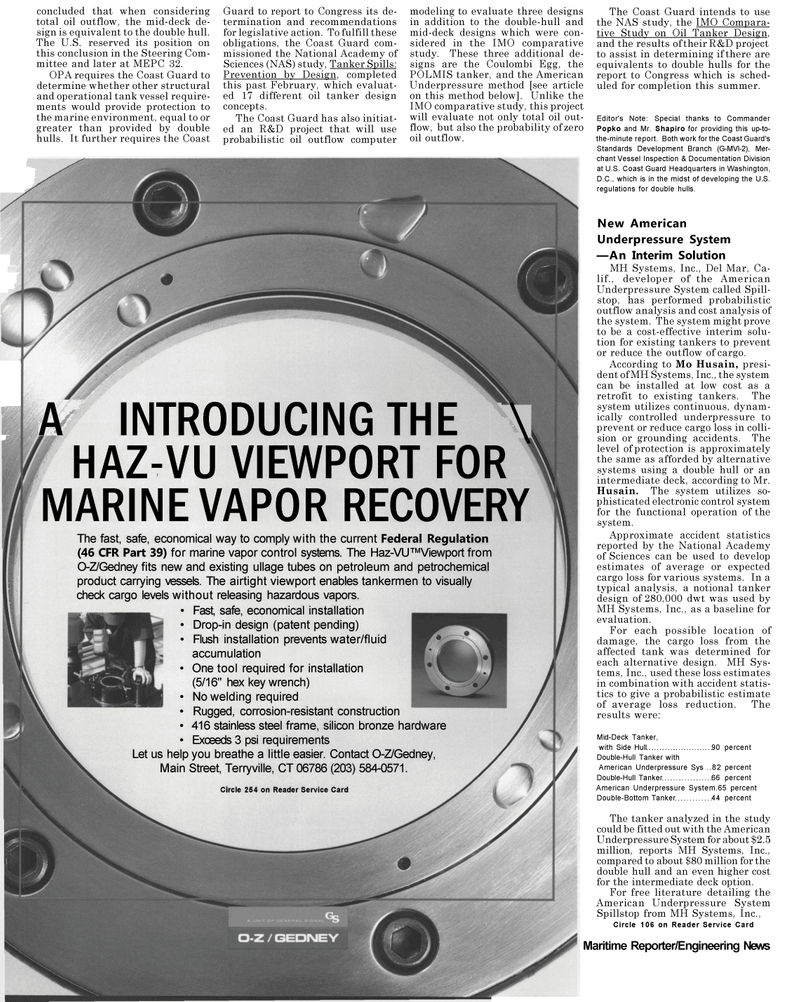
Page 24: of Maritime Reporter Magazine (May 1992)
Read this page in Pdf, Flash or Html5 edition of May 1992 Maritime Reporter Magazine
A INTRODUCING THE \ HAZ-VU VIEWPORT FOR
MARINE VAPOR RECOVERY
The Coast Guard intends to use the NAS study, the IMO Compara- tive Study on Oil Tanker Design, and the results of their R&D project to assist in determining if there are equivalents to double hulls for the report to Congress which is sched- uled for completion this summer.
Editor's Note: Special thanks to Commander
Popko and Mr. Shapiro for providing this up-to- the-minute report. Both work for the Coast Guard's
Standards Development Branch (G-MVI-2), Mer- chant Vessel Inspection & Documentation Division at U.S. Coast Guard Headquarters in Washington,
D.C., which is in the midst of developing the U.S. regulations for double hulls.
New American
Underpressure System —An Interim Solution
MH Systems, Inc., Del Mar, Ca- lif., developer of the American
Underpressure System called Spill- stop, has performed probabilistic outflow analysis and cost analysis of the system. The system might prove to be a cost-effective interim solu- tion for existing tankers to prevent or reduce the outflow of cargo.
According to Mo Husain, presi- dent of MH Systems, Inc., the system can be installed at low cost as a retrofit to existing tankers. The system utilizes continuous, dynam- ically controlled underpressure to prevent or reduce cargo loss in colli- sion or grounding accidents. The level of protection is approximately the same as afforded by alternative systems using a double hull or an intermediate deck, according to Mr.
Husain. The system utilizes so- phisticated electronic control system for the functional operation of the system.
Approximate accident statistics reported by the National Academy of Sciences can be used to develop estimates of average or expected cargo loss for various systems. In a typical analysis, a notional tanker design of 280,000 dwt was used by
MH Systems, Inc., as a baseline for evaluation.
For each possible location of damage, the cargo loss from the affected tank was determined for each alternative design. MH Sys- tems, Inc., used these loss estimates in combination with accident statis- tics to give a probabilistic estimate of average loss reduction. The results were:
Mid-Deck Tanker, with Side Hull 90 percent
Double-Hull Tanker with
American Underpressure Sys ..82 percent
Double-Hull Tanker 66 percent
American Underpressure System.65 percent
Double-Bottom Tanker 44 percent
The tanker analyzed in the study could be fitted out with the American
Underpressure System for about $2.5 million, reports MH Systems, Inc., compared to about $80 million for the double hull and an even higher cost for the intermediate deck option.
For free literature detailing the
American Underpressure System
Spillstop from MH Systems, Inc.,
Circle 106 on Reader Service Card
Maritime Reporter/Engineering News concluded that when considering total oil outflow, the mid-deck de- sign is equivalent to the double hull.
The U.S. reserved its position on this conclusion in the Steering Com- mittee and later at MEPC 32.
OPA requires the Coast Guard to determine whether other structural and operational tank vessel require- ments would provide protection to the marine environment, equal to or greater than provided by double hulls. It further requires the Coast
Guard to report to Congress its de- termination and recommendations for legislative action. To fulfill these obligations, the Coast Guard com- missioned the National Academy of
Sciences (NAS) study, Tanker Spills:
Prevention by Design, completed this past February, which evaluat- ed 17 different oil tanker design concepts.
The Coast Guard has also initiat- ed an R&D project that will use probabilistic oil outflow computer modeling to evaluate three designs in addition to the double-hull and mid-deck designs which were con- sidered in the IMO comparative study. These three additional de- signs are the Coulombi Egg, the
POLMIS tanker, and the American
Underpressure method [see article on this method below]. Unlike the
IMO comparative study, this project will evaluate not only total oil out- flow, but also the probability of zero oil outflow.
The fast, safe, economical way to comply with the current Federal Regulation (46 CFR Part 39) for marine vapor control systems. The Haz-VU™Viewport from
O-Z/Gedney fits new and existing ullage tubes on petroleum and petrochemical product carrying vessels. The airtight viewport enables tankermen to visually check cargo levels without releasing hazardous vapors. • Fast, safe, economical installation • Drop-in design (patent pending) • Flush installation prevents water/fluid accumulation • One tool required for installation (5/16" hex key wrench) • No welding required • Rugged, corrosion-resistant construction • 416 stainless steel frame, silicon bronze hardware • Exceeds 3 psi requirements
Let us help you breathe a little easier. Contact O-Z/Gedney,
Main Street, Terryville, CT 06786 (203) 584-0571.
Circle 254 on Reader Service Card

 23
23

 25
25
